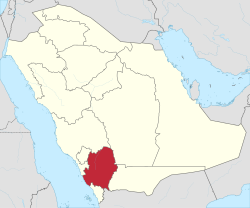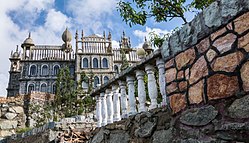Asir
South-Western administrative region of Saudi Arabia bordering Yemen From Wikipedia, the free encyclopedia
Asir,[a][b] officially the Aseer Province,[c] is a province of Saudi Arabia in southern Arabia. It has an area of 76,693 square kilometres (29,611 sq mi), and an estimated population of 2,024,285 (in 2022).[1] Asir is bounded by the Mecca Province to the north and west, al-Bahah Province to the northwest, Riyadh Province to the northeast, Najran Province to the southeast, Jazan Province and the Saada Governorate of Yemen to the south.
Asir
عَسِيْرٌ | |
|---|---|
| Asir Province (Arabic: مِنْطَقَةُ عَسِيْرٌ, romanized: Minṭaqat ʿAsīr) | |
Rijal Almaa Heritage Village Art Street, Abha Al-Maqar Palace, Al-Namas Al-Hawzah Heritage Village, Dhahran Al-Janub | |
|
| |
 Map of Saudi Arabia with Asir highlighted | |
| Coordinates: 19°0′N 43°0′E | |
| Country | Saudi Arabia |
| Capital | Abha |
| Boroughs | 13 |
| Government | |
| • Governor | Prince Turki bin Talal |
| Area | |
• Total | 76,693 km2 (29,611 sq mi) |
| Population (2022 census) | |
• Total | 2,024,285 |
| ISO 3166-2 | 14 |
| Website | ars discoveraseer |
Abha is the provincial capital, and other towns include Khamis Mushait, Bisha and Bareq. The province governor is Turki bin Talal, He replaced his cousin, Faisal bin Khalid, after being appointed on 27 December 2018.[2]
Etymology
The origin of the name "Asir" remains a subject of debate among historians. One theory, proposed by Al-Masudi in his work The Meadows of Gold, suggests that the region was originally known as the "land of Azd".[3]
Another popular hypothesis suggests that the name "Asir" derives from the Arabic term ʿUsrah (Arabic: عُسرة, lit. 'Hardship'). This theory comes from the fact that the region's terrain is rugged, which can be challenging to navigate.[4]
A third perspective proposed by Fuad Hamza in his book Fi bilad ʿAseer, links the name to the historical prominence of Banu Asir.[5] As the tribe gained power and influence, its name came to encompass the surrounding territories and tribes.[5] This association was reinforced by the close ties between the Asir tribe and many of the ruling emirs in the region, including those from the Al Yazid, Al Muthami, and Al A'ad families.[5]
History
Summarize
Perspective
Ancient history
In 25 B.C., Aelius Gallus marched his legions south from Egypt on an expedition of 1,300 miles (2,100 kilometres), to take control of the ancient overland trade routes between the Mediterranean Sea and what is now Hadhramaut in Yemen. The Romans wanted control of those routes because they were desperate for money and hoped to raise some by capturing Ma'rib, capital of Sabaʾ, and taking control of the trade in incense – then a priceless commodity – and other valuable aromatics. As it turned out, however, the expedition was a disaster and little information about ʿAsir emerged.[6]
Modern history
When the First Saudi State was destroyed by the Egyptians in 1818, the 'Asiris continued to fight the Egyptian forces in their region tenaciously. With the withdrawal of the Egyptians in 1840, the dynasty of Al-Ayedh, also of Mughayd, took control of the 'Asir highlands. The Al Ayedh generally allied themselves to the Saudis, who had re-established their dynasty in 1824, but did not formally enter under their command. As the Al Ayedh attempted to expand into the Tihama lowlands (present-day Jazan Province), the Ottoman Turks felt provoked to invade and occupy the highlands. They defeated and executed the leader of Al Ayedh in 1872 and established a mutasarrifiyya (a sub-governorate) in Abha attached to the Yemen vilayet. Their rule, however, seldom extended far from the isolated forts where their troops were garrisoned.[7]
In about 1906, Muhammad ibn Ali al-Idrisi, a descendant of Ahmad Ibn Idris, began to establish political control of Asir. After negotiations with Italy, which had interests nearby in Somalia, the Idrisi forces of Muhammad came into conflict with Ottoman forces in Abha. The Idrisis were defeated in 1911 by Hashemite forces under Hussein ibn Ali, Sharif of Mecca, then still loyal to the Ottomans, but the tide turned when Muhammad ibn Ali concluded a secret military alliance with Great Britain (by then at war with the Ottomans) in 1915, and Sharif Hussein later switched sides and joined the British against the Ottomans.
After the end of First World War, Muhammad ibn Ali became ruler of an internationally recognized sovereign state, the Idrisi Emirate of Asir, until his death in 1920. The territories of the emirate reached from Abha in the north to Hudaydah in the south. Muhammad's successors were however unable to resist the growing power of Abd Al-Aziz Ibn Saud, who began annexing 'Asir and its neighboring regions after Muhammad's death, initially intervening under the pretext of mediating between the Al Ayedh of 'Asir and the Idrisis. The Saudis took control of the regional capital Abha in 1920, and incorporated the rest of 'Asir by 1923.[7] Ibn Saud later successfully fought off a rival claim for the region by the Zaydi Imam of neighboring Yemen in 1934.
By 1920, however, Ibn Saud, the founder of the modern Saudi state, had begun to recoup the losses of the House of Saud, and to unify most of the peninsula under his rule. As part of this campaign, he sent his Bedouin warriors also known as the Ikhwan to occupy ʿAsir, and the ruler of the region, Hasan Al Idrissi, had to leave.[8] Therefore, he asked for protection from Imam Yahya, the ruler of Yemen and went there.[8] From then on ʿAsir has been controlled by the House of Saud, a situation formalized in 1934 with the signing of the Treaty of Taʾif between Saudi Arabia and Yemen. Even then the region was still largely unknown to the West. In 1932, St John Philby, one of the first Europeans to explore and map the peninsula, did enter ʿAsir, but as he did not publish his observations until 1952, the area remained one of the blank spots on the world's map.[9] In 1935 ʿAsir was made a separate governorate.[10]
Mass shootings of Ethiopian refugees
Since 2014 refugees are killed after crossing the Saudi border by the Saudi Border Guard. Since 2023 at least several hundred Ethiopian refugees have been killed at the border between Yemen and the provinces Jazan, Asir and Najran. The Saudis have also used explosive weapons.[11][12]
Economy
Historically, ʿAsir was known for producing coffee, wheat, alfalfa, barley, senna, and frankincense.[13][14][15] Wheat was grown in the summer and sesame has been grown in wetter areas of the region.[14][16] Straw was used to make mats, hats, and baskets. Tribes in the area also wove tents from straw.[17]
Modern development projects
In 2019, the Saudi government launched an infrastructure development project in ʿAsir Region. The project is expected to cost more than 1 billion Saudi Riyals. The provided projects will include health care, transportation and municipal services.[18] The project is in line with the Saudi Vision 2030 to diversify non-petroleum income and activate new resources in Saudi Arabia.[18]
In 2023, Crown Prince Mohammed bin Salman launched Soudah Peaks Project to develop a tourism destination in Saudi Arabia's highest peak, Jabal Soudah.[19] Soudah Peaks is a planned luxury mountain tourism destination located at 3,015 meters above sea level.
Geography
Summarize
Perspective

The ʿAsir Region is situated on a high plateau that receives more rainfall than the rest of the country and contains the country's highest peaks, which rise to almost 3,000 metres (9,800 ft) at Jabal Sawda near Abha. Though data is exceedingly sparse and unreliable, the average annual rainfall in the highlands probably ranges from 300–500 millimetres (12–20 in). It falls in two rainy seasons, the chief one being in March and April, with some rain in the summer. Temperatures are very extreme, with diurnal temperature ranges in the highlands the greatest in the world. It is common[clarification needed] for afternoon temperatures to be over 30 °C (86 °F), yet mornings can be extremely frosty and fog can cut visibility to near zero percent. As a result, there is much more natural vegetation in ʿAsir than in any other part of Saudi Arabia, with sheltered areas even containing areas of dense coniferous forests, though more exposed ridges still are very dry. ʿAsir is home to many farmers who chiefly grow wheat and fruit crops. Irrigation has greatly expanded production in modern times. Asir National Park was established in 1981, and extends from the Red Sea coast through the western foothills to the Asir escarpment.[20]
Demographics
| Year | Pop. | ±% p.a. |
|---|---|---|
| 1992 | 1,340,168 | — |
| 2004 | 1,687,939 | +1.94% |
| 2010 | 1,927,087 | +2.23% |
| 2022 | 2,024,285 | +0.41% |
| source:[21] | ||
Governorates

The region is divided into sixteen governorates (with the populations of the Census of 2022):[22]
- Abha (+422,243)
- Muhayil (+230,537)
- An-Namas (+38,409)
- Balqarn (+60,012)
- Bareq (+44,880)
- Bisha (+202,096)
- Khamis Mushayt (+601,305)
- Rijal Almaa (+50,825)
- Tanomah (+17,756)
- Dhahran Al Janub (+32,099)
- Tathlith (+36,451)
- Sarat Ubaida (+57,123)
- Ahad Rafidah (+107,894)
- Al Majaridah (+48,302)
- Al Harajah (+18,503)
- Tarib (+22,298)
- Al Amoah (+10,969)
- Al Birk (+22,583)
List of governors
- Turki bin Ahmed Al-Sudairi (1900s–8 June 1969)[23]
- Fahd bin Saad bin Abdul Rahman (8 June 1969–1971)[23]
- Khalid Al-Faisal (1971–2007)
- Faisal bin Khalid (2007–2018)
- Turki bin Talal (2018–present)
See also
Notes
References
External links
Wikiwand - on
Seamless Wikipedia browsing. On steroids.





